You need to develop procedures to verify resilience of disaster recovery for remote recovery using GCP. Your production environment is hosted on-premises. You need to establish a secure, redundant connection between your on premises network and the GCP network.
What should you do?
Your company has developed a monolithic, 3-tier application to allow external users to upload and share files. The solution cannot be easily enhanced and lacks reliability. The development team would like to re-architect the application to adopt microservices and a fully managed service approach, but they need to convince their leadership that the effort is worthwhile. Which advantage(s) should they highlight to leadership?
Your architecture calls for the centralized collection of all admin activity and VM system logs within your
project.
How should you collect these logs from both VMs and services?
Your company has an application deployed on Anthos clusters (formerly Anthos GKE) that is running multiple microservices. The cluster has both Anthos Service Mesh and Anthos Config Management configured. End users inform you that the application is responding very slowly. You want to identify the microservice that is causing the delay. What should you do?
Your organization has decided to restrict the use of external IP addresses on instances to only approved instances. You want to enforce this requirement across all of your Virtual Private Clouds (VPCs). What should you do?
A recent audit that a new network was created in Your GCP project. In this network, a GCE instance has an SSH port open the world. You want to discover this network's origin. What should you do?
To reduce costs, the Director of Engineering has required all developers to move their development infrastructure resources from on-premises virtual machines (VMs) to Google Cloud Platform. These resources go through multiple start/stop events during the day and require state to persist. You have been asked to design the process of running a development environment in Google Cloud while providing cost visibility to the finance department. Which two steps should you take? Choose 2 answers
Your development teams release new versions of games running on Google Kubernetes Engine (GKE) daily.
You want to create service level indicators (SLIs) to evaluate the quality of the new versions from the user’s
perspective. What should you do?
Mountkirk Games wants you to secure the connectivity from the new gaming application platform to Google
Cloud. You want to streamline the process and follow Google-recommended practices. What should you do?
For this question, refer to the Mountkirk Games case study. Which managed storage option meets Mountkirk’s technical requirement for storing game activity in a time series database service?
For this question, refer to the Mountkirk Games case study. Mountkirk Games wants you to design a way to test the analytics platform’s resilience to changes in mobile network latency. What should you do?
Your development team has created a mobile game app. You want to test the new mobile app on Android and
iOS devices with a variety of configurations. You need to ensure that testing is efficient and cost-effective. What
should you do?
You are implementing Firestore for Mountkirk Games. Mountkirk Games wants to give a new game
programmatic access to a legacy game's Firestore database. Access should be as restricted as possible. What
should you do?
You need to optimize batch file transfers into Cloud Storage for Mountkirk Games’ new Google Cloud solution.
The batch files contain game statistics that need to be staged in Cloud Storage and be processed by an extract
transform load (ETL) tool. What should you do?
For this question, refer to the Mountkirk Games case study. You need to analyze and define the technical architecture for the database workloads for your company, Mountkirk Games. Considering the business and technical requirements, what should you do?
For this question, refer to the Mountkirk Games case study. You are in charge of the new Game Backend Platform architecture. The game communicates with the backend over a REST API.
You want to follow Google-recommended practices. How should you design the backend?
The current Dress4win system architecture has high latency to some customers because it is located in one
data center.
As of a future evaluation and optimizing for performance in the cloud, Dresss4win wants to distribute it's system
architecture to multiple locations when Google cloud platform.
Which approach should they use?
For this question, refer to the Dress4Win case study.
Dress4Win has asked you for advice on how to migrate their on-premises MySQL deployment to the cloud. They want to minimize downtime and performance impact to their on-premises solution during the migration. Which approach should you recommend?
For this question, refer to the Dress4Win case study.
The Dress4Win security team has disabled external SSH access into production virtual machines (VMs) on Google Cloud Platform (GCP). The operations team needs to remotely manage the VMs, build and push Docker containers, and manage Google Cloud Storage objects. What can they do?
For this question, refer to the Dress4Win case study.
Dress4Win has asked you to recommend machine types they should deploy their application servers to. How should you proceed?
Dress4win has end to end tests covering 100% of their endpoints.
They want to ensure that the move of cloud does not introduce any new bugs.
Which additional testing methods should the developers employ to prevent an outage?
For this question, refer to the Dress4Win case study.
As part of their new application experience, Dress4Wm allows customers to upload images of themselves. The customer has exclusive control over who may view these images. Customers should be able to upload images with minimal latency and also be shown their images quickly on the main application page when they log in. Which configuration should Dress4Win use?
For this question, refer to the Dress4Win case study.
Dress4Win has configured a new uptime check with Google Stackdriver for several of their legacy services. The Stackdriver dashboard is not reporting the services as healthy. What should they do?
For this question, refer to the Dress4Win case study.
As part of Dress4Win's plans to migrate to the cloud, they want to be able to set up a managed logging and monitoring system so they can handle spikes in their traffic load. They want to ensure that:
• The infrastructure can be notified when it needs to scale up and down to handle the ebb and flow of usage throughout the day
• Their administrators are notified automatically when their application reports errors.
• They can filter their aggregated logs down in order to debug one piece of the application across many hosts
Which Google StackDriver features should they use?
For this question, refer to the Dress4Win case study.
Dress4Win has end-to-end tests covering 100% of their endpoints. They want to ensure that the move to the cloud does not introduce any new bugs. Which additional testing methods should the developers employ to prevent an outage?
For this question, refer to the TerramEarth case study
You analyzed TerramEarth's business requirement to reduce downtime, and found that they can achieve a majority of time saving by reducing customers' wait time for parts You decided to focus on reduction of the 3 weeks aggregate reporting time Which modifications to the company's processes should you recommend?
For this question, refer to the TerramEarth case study.
To speed up data retrieval, more vehicles will be upgraded to cellular connections and be able to transmit data to the ETL process. The current FTP process is error-prone and restarts the data transfer from the start of the file when connections fail, which happens often. You want to improve the reliability of the solution and minimize data transfer time on the cellular connections. What should you do?
For this question, refer to the TerramEarth case study.
TerramEarth has equipped unconnected trucks with servers and sensors to collet telemetry data. Next year they want to use the data to train machine learning models. They want to store this data in the cloud while reducing costs. What should they do?
For this question, refer to the TerramEarth case study.
TerramEarth's CTO wants to use the raw data from connected vehicles to help identify approximately when a vehicle in the development team to focus their failure. You want to allow analysts to centrally query the vehicle data. Which architecture should you recommend?
A)
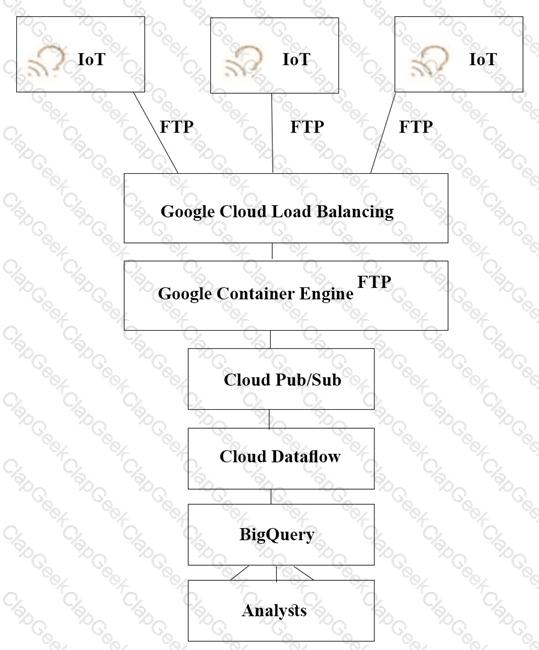
B)
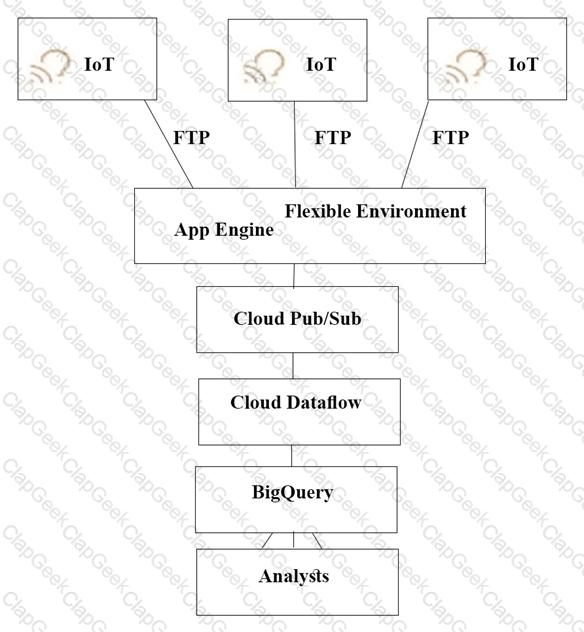
C)
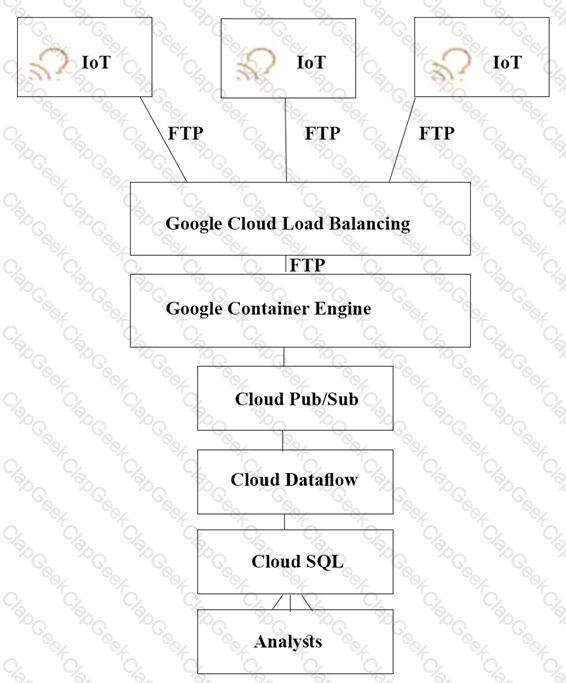
D)
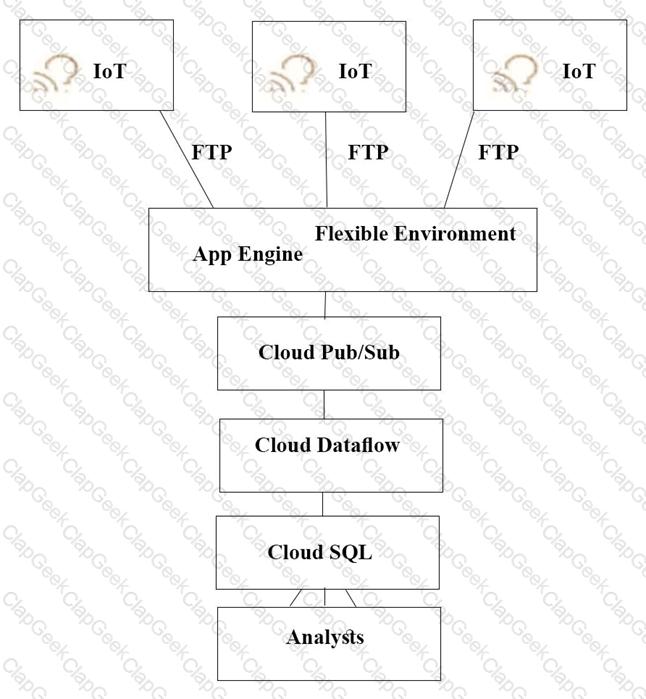
For this question, refer to the JencoMart case study.
The migration of JencoMart’s application to Google Cloud Platform (GCP) is progressing too slowly. The infrastructure is shown in the diagram. You want to maximize throughput. What are three potential bottlenecks? (Choose 3 answers.)
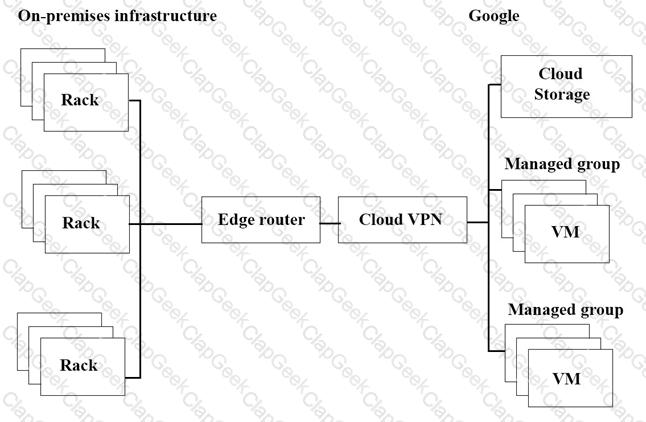
For this question, refer to the Helicopter Racing League (HRL) case study. The HRL development team
releases a new version of their predictive capability application every Tuesday evening at 3 a.m. UTC to a
repository. The security team at HRL has developed an in-house penetration test Cloud Function called Airwolf.
The security team wants to run Airwolf against the predictive capability application as soon as it is released
every Tuesday. You need to set up Airwolf to run at the recurring weekly cadence. What should you do?
For this question, refer to the Helicopter Racing League (HRL) case study. Recently HRL started a new regional
racing league in Cape Town, South Africa. In an effort to give customers in Cape Town a better user
experience, HRL has partnered with the Content Delivery Network provider, Fastly. HRL needs to allow traffic
coming from all of the Fastly IP address ranges into their Virtual Private Cloud network (VPC network). You are
a member of the HRL security team and you need to configure the update that will allow only the Fastly IP
address ranges through the External HTTP(S) load balancer. Which command should you use?
For this question, refer to the JencoMart case study.
JencoMart has decided to migrate user profile storage to Google Cloud Datastore and the application servers to Google Compute Engine (GCE). During the migration, the existing infrastructure will need access to Datastore to upload the data. What service account key-management strategy should you recommend?
For this question, refer to the JencoMart case study.
JencoMart has built a version of their application on Google Cloud Platform that serves traffic to Asia. You want to measure success against their business and technical goals. Which metrics should you track?
Your agricultural division is experimenting with fully autonomous vehicles.
You want your architecture to promote strong security during vehicle operation.
Which two architecture should you consider?
Choose 2 answers:
For this question, refer to the JencoMart case study.
JencoMart wants to move their User Profiles database to Google Cloud Platform. Which Google Database should they use?
For this question, refer to the JencoMart case study
A few days after JencoMart migrates the user credentials database to Google Cloud Platform and shuts down the old server, the new database server stops responding to SSH connections. It is still serving database requests to the application servers correctly. What three steps should you take to diagnose the problem? Choose 3 answers
For this question, refer to the JencoMart case study.
The JencoMart security team requires that all Google Cloud Platform infrastructure is deployed using a least privilege model with separation of duties for administration between production and development resources. What Google domain and project structure should you recommend?
For this question refer to the TerramEarth case study.
Which of TerramEarth's legacy enterprise processes will experience significant change as a result of increased Google Cloud Platform adoption.
For this question, refer to the TerramEarth case study.
The TerramEarth development team wants to create an API to meet the company's business requirements. You want the development team to focus their development effort on business value versus creating a custom framework. Which method should they use?
For this question, refer to the TerramEarth case study.
TerramEarth's 20 million vehicles are scattered around the world. Based on the vehicle's location its telemetry data is stored in a Google Cloud Storage (GCS) regional bucket (US. Europe, or Asia). The CTO has asked you to run a report on the raw telemetry data to determine why vehicles are breaking down after 100 K miles. You want to run this job on all the data. What is the most cost-effective way to run this job?
For this question, refer to the TerramEarth case study.
TerramEarth plans to connect all 20 million vehicles in the field to the cloud. This increases the volume to 20 million 600 byte records a second for 40 TB an hour. How should you design the data ingestion?
For this question, refer to the TerramEarth case study. Considering the technical requirements, how should you reduce the unplanned vehicle downtime in GCP?
TerramEarth has about 1 petabyte (PB) of vehicle testing data in a private data center. You want to move the data to Cloud Storage for your machine learning team. Currently, a 1-Gbps interconnect link is available for you. The machine learning team wants to start using the data in a month. What should you do?
You have broken down a legacy monolithic application into a few containerized RESTful microservices. You want to run those microservices on Cloud Run. You also want to make sure the services are highly available with low latency to your customers. What should you do?
For this question, refer to the TerramEarth case study. TerramEarth has decided to store data files in Cloud Storage. You need to configure Cloud Storage lifecycle rule to store 1 year of data and minimize file storage cost.
Which two actions should you take?
For this question, refer to the TerramEarth case study. You are asked to design a new architecture for the
ingestion of the data of the 200,000 vehicles that are connected to a cellular network. You want to follow
Google-recommended practices.
Considering the technical requirements, which components should you use for the ingestion of the data?
TerramEarth has a legacy web application that you cannot migrate to cloud. However, you still want to build a cloud-native way to monitor the application. If the application goes down, you want the URL to point to a "Site is unavailable" page as soon as possible. You also want your Ops team to receive a notification for the issue. You need to build a reliable solution for minimum cost
What should you do?
For this question, refer to the TerramEarth case study.
You start to build a new application that uses a few Cloud Functions for the backend. One use case requires a Cloud Function func_display to invoke another Cloud Function func_query. You want func_query only to accept invocations from func_display. You also want to follow Google's recommended best practices. What should you do?
For this question, refer to the TerramEarth case study. You need to implement a reliable, scalable GCP solution for the data warehouse for your company, TerramEarth. Considering the TerramEarth business and technical requirements, what should you do?
For this question, refer to the TerramEarth case study. A new architecture that writes all incoming data to
BigQuery has been introduced. You notice that the data is dirty, and want to ensure data quality on an
automated daily basis while managing cost.
What should you do?
For this question, refer to the Mountkirk Games case study
Mountkirk Games needs to create a repeatable and configurable mechanism for deploying isolated application environments. Developers and testers can access each other's environments and resources, but they cannot access staging or production resources. The staging environment needs access to some services from production.
What should you do to isolate development environments from staging and production?
For this question, refer to the Mountkirk Games case study.
Mountkirk Games' gaming servers are not automatically scaling properly. Last month, they rolled out a new feature, which suddenly became very popular. A record number of users are trying to use the service, but many of them are getting 503 errors and very slow response times. What should they investigate first?
For this question, refer to the Mountkirk Games case study.
Mountkirk Games wants to set up a real-time analytics platform for their new game. The new platform must meet their technical requirements. Which combination of Google technologies will meet all of their requirements?
For this question, refer to the Mountkirk Games case study.
Mountkirk Games has deployed their new backend on Google Cloud Platform (GCP). You want to create a thorough testing process for new versions of the backend before they are released to the public. You want the testing environment to scale in an economical way. How should you design the process?
For this question, refer to the Mountkirk Games case study.
Mountkirk Games wants you to design their new testing strategy. How should the test coverage differ from their existing backends on the other platforms?
For this question, refer to the Mountkirk Games case study.
Mountkirk Games wants to set up a continuous delivery pipeline. Their architecture includes many small services that they want to be able to update and roll back quickly. Mountkirk Games has the following requirements:
• Services are deployed redundantly across multiple regions in the US and Europe.
• Only frontend services are exposed on the public internet.
• They can provide a single frontend IP for their fleet of services.
• Deployment artifacts are immutable.
Which set of products should they use?
For this question, refer to the EHR Healthcare case study. You are a developer on the EHR customer portal team. Your team recently migrated the customer portal application to Google Cloud. The load has increased on the application servers, and now the application is logging many timeout errors. You recently incorporated Pub/Sub into the application architecture, and the application is not logging any Pub/Sub publishing errors. You want to improve publishing latency. What should you do?
For this question, refer to the EHR Healthcare case study. You need to define the technical architecture for hybrid connectivity between EHR's on-premises systems and Google Cloud. You want to follow Google's recommended practices for production-level applications. Considering the EHR Healthcare business and technical requirements, what should you do?
For this question, refer to the EHR Healthcare case study. You are responsible for designing the Google Cloud network architecture for Google Kubernetes Engine. You want to follow Google best practices. Considering the EHR Healthcare business and technical requirements, what should you do to reduce the attack surface?
For this question, refer to the Dress4Win case study. Dress4Win is expected to grow to 10 times its size in 1 year with a corresponding growth in data and traffic that mirrors the existing patterns of usage. The CIO has set the target of migrating production infrastructure to the cloud within the next 6 months. How will you configure the solution to scale for this growth without making major application changes and still maximize the ROI?
For this question, refer to the Dress4Win case study. You want to ensure that your on-premises architecture meets business requirements before you migrate your solution.
What change in the on-premises architecture should you make?
For this question, refer to the Dress4Win case study. Considering the given business requirements, how would you automate the deployment of web and transactional data layers?
For this question, refer to the Dress4Win case study. You are responsible for the security of data stored in
Cloud Storage for your company, Dress4Win. You have already created a set of Google Groups and assigned the appropriate users to those groups. You should use Google best practices and implement the simplest design to meet the requirements.
Considering Dress4Win’s business and technical requirements, what should you do?
For this question, refer to the Dress4Win case study. Which of the compute services should be migrated as –is and would still be an optimized architecture for performance in the cloud?
For this question, refer to the Dress4Win case study. To be legally compliant during an audit, Dress4Win must be able to give insights in all administrative actions that modify the configuration or metadata of resources on Google Cloud.
What should you do?


